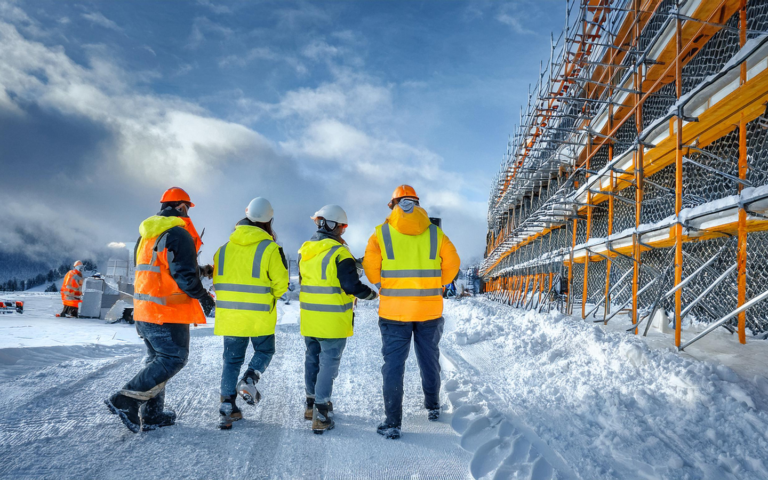
Experiencing Workplace Accidents and Injuries: Winter Risks in the Construction, Manufacturing, and Railroad Industries.

Winter presents unique challenges to workplace safety, particularly in industries such as construction, manufacturing, and railroads. Cold weather and snow significantly increase the risk of accidents, including slips, trips, falls, and cold-related illnesses like hypothermia. This article explores these risks, identifies their causes, and proposes prevention strategies grounded in OSHA standards and industry-specific best practices.
Workplace safety during the winter season is critical, as adverse weather conditions significantly increase the likelihood of accidents. Icy walkways, freezing temperatures, and snow-covered equipment pose risks to employees, especially in high-risk industries like construction, manufacturing, and railroads. Despite advances in safety protocols, the Bureau of Labor Statistics (BLS) reports that slip, trip, and fall incidents remain a leading cause of workplace injuries during the winter (Injuries, Illnesses, and Fatalities, 2022). This article provides an overview of winter hazards, prevention strategies, and the regulatory framework to ensure safety.
Common Winter Hazards
Construction Industry:
- Icy scaffolding, snow-covered walkways, and freezing conditions can cause severe injuries.
- Workers face risks of frostbite and hypothermia when exposed to cold for prolonged periods.
Manufacturing Industry:
- Cold stress affects workers handling outdoor equipment or working in unheated facilities.
- Equipment malfunctions due to freezing temperatures disrupt operations and create safety hazards.
Railroad Industry:
- Frozen tracks increase the risk of derailments.
- Outdoor workers face challenges maintaining equipment in snow and ice.
Prevention Strategies
Personal Protective Equipment (PPE):
Thermal PPE, including insulated gloves, anti-slip footwear, and heated jackets, is critical for protecting workers. Proper PPE minimizes risks of frostbite and other cold-related injuries (Winter Weather, 2023).
De-Icing Protocols:
Regular de-icing of walkways, tracks, and scaffolds is essential. Salt and other de-icing chemicals can prevent ice accumulation and reduce slip-and-fall accidents.
Worker Training:
Training programs should educate workers about recognizing symptoms of cold stress and following safe practices. This aligns with OSHA’s guidelines for cold stress prevention (Winter Weather, 2023).
Equipment Maintenance:
Regular maintenance checks prevent freezing and malfunctions. Equipment manufacturers often provide winter-specific maintenance protocols (American National Standards Maintained Under Continuous Maintenance, 2024).
Regulatory Compliance
OSHA regulations such as 29 CFR 1926.95 (Criteria for Personal Protective Equipment, 2024) and 29 CFR 1910.132 (Personal Protective Equipment, 2016) outline essential safety measures. The Federal Railroad Administration (FRA) provides additional guidelines for winter operations in the railroad industry. Employers must ensure compliance to minimize liabilities and enhance worker safety.
Conclusion
Winter safety requires proactive measures and a commitment to compliance. By prioritizing worker training, PPE, and regular inspections, employers in construction, manufacturing, and railroads can mitigate winter risks and create safer work environments.
References
Bureau of Labor Statistics. (2022). Injuries, Illnesses, and Fatalities. https://www.bls.gov/iif/#:~:text=There%20were%205%2C283%20fatal%20work,down%20from%203.7%20in%202022.
Occupational Safety and Health Administration. (2023). Winter weather. https://www.osha.gov/winter-weather
Standard for Criteria for Personal Protective Equipment. OSHA 29 CFR 1926 Subpart E § 1926.95 (2024) https://www.ecfr.gov/current/title-29/subtitle-B/chapter-XVII/part-1926/subpart-E/section-1926.95
Standard for Criteria for Personal Protective Equipment. OSHA 29 CFR 1910 Subpart I § 1910.132 (2016) https://www.osha.gov/laws-regs/regulations/standardnumber/1910/1910.132
American National Standards Institute. (2024). American National Standards Maintained Under Continuous Maintenance. https://share.ansi.org/Shared%20Documents/Standards%20Activities/American%20National%20Standards/ANS%20Under%20Continuous%20Maintenance/Continuous%20Maintenance%20PDF.pdf

